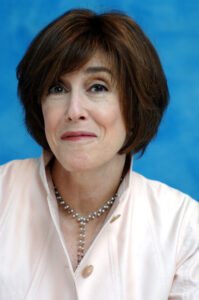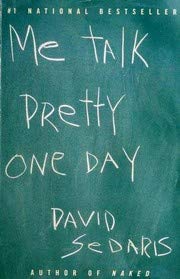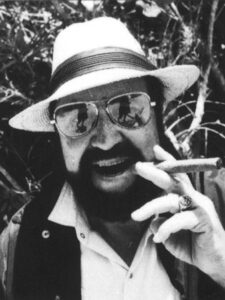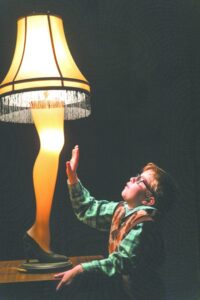
You better make them care…It better be quirky or perverse or thoughtful enough so that you hit some chord in them. Otherwise, it doesn’t work. I mean we’ve all read pieces where we thought, “Oh, who gives a damn?” — Nora Ephron.
I feel like now people want more of a mirror. They want to see themselves in the book that they’re reading. — David Sedaris
By PJ Parrish
Well, it’s officially Christmas season. I know this because Ralphie is whining about getting a Red Ryder air rifle. Every time A Christmas Story comes on, I am reminded of my own childhood. But I’m also reminded how dependent writers are on our powers of observation and also our storehouses of life experience. And how we use that to connect with our readers.
This point is especially clear to me because I’ve been reading Nora Ephron’s Wallflower at the Orgy, her dispatches as a reporter about the cultural upheavals of the late ’60s. Here’s the opening:
Some years ago, the man I am married to told me he had always had a mad desire to go to an orgy. Why on earth, I asked. Why not, he said. Because, I replied, it would be just like the dances at the YMCA I went to in the seventh grade—only instead of people walking past me and rejecting me, they would be stepping over my naked body and rejecting me. The image made no impression at all on my husband. But it has stayed with me—albeit in another context. Because working as a journalist is exactly like being the wallflower at the orgy. I always seem to find myself at a perfectly wonderful event where everyone else is having a marvelous time, laughing merrily, eating, drinking, having sex in the back room, and I am standing on the side taking notes on it all.

Nora Ephron, director (Photo by Vera Anderson/WireImage)
Which pretty much summarized how I often felt during the ’60s and later when I worked as a reporter. But that’s the beauty of a great writer like Ephron, and why I am drawn to essayists. They see things more sharply than average folk. And they spin what they see into great stories that anyone can relate to. Which is pretty much what we novelists should be trying to do.
You have to connect. But easier said than done, as any writer knows. I remember reading a First Novel Edgar winner a couple years back. Man, the writing just sang! Gorgeous description, a lean neo-noir sensibility. But I always felt as if the writer was holding back emotionally. And this arms-length style eventually left me thinking, “who gives a damn?”
You have to connect. Some things to think about as you grapple with this.
Make your subject relatable in experience. Nora Ephron wrote a terrific essay called “A Few Words About Breasts.” It was about her agony, as a tomboy, waiting for her breasts to “develop.” When she begged her mother for a bra, her mom said “What for?” She recounts the horror of going alone to the department store and getting fitted for a size 28AA. When I read it, I was smiling, nodding and ultimately crying.
Many moons later, I happened upon her essay on aging gracefully called “On Maintenance.” Best line about how getting hair highlights changed her life: “…a little like that first brandy Alexander Lee Remick drank in Days of Wine and Roses.”

Use Your Experiences to Find Your Own Voice. Another of my favorite writers is also an essayist — David Sedaris. Why do his essays connect with readers? Because he writes with wit and humility of his own experiences. He is a storyteller you want to spend your hours with. His essay on learning French “Me Talk Pretty One Day” articulated all the terror I felt in my first French adult ed course: “Learning French is a lot like joining a gang in that it involves a long and intensive period of hazing.” I’m now taking online Babbel courses now and every time I am “buzzed” for incorrect pronunciation — I have a heavy Detroit/Michigan accent, so I will never say anything in French pretty — I think of Sedaris. He’s got some really good advice for writers. Click here. This one is among my favorites:
Sad stories, dashed dreams, and memorable mistakes are ammunition for writers. Any experience can be converted into a story, and rough experiences often make the best stories. As a writer, failure is soil for growing heartfelt stories. Vulnerability is a powerful draw. Write down your biggest failures, then review the list to see which ones can be marshaled into relatable stories for your readers.
And about that voice thing? Don’t sweat it too much. When you’re just starting out, you might not be able to articulate exactly what you are trying, in your heart and soul, to get across. So be content with trying to become the best damn storyteller you can. If you are successful at that, the voice thing will emerge by itself. As Neil Gaiman says:
After you’ve written 10,000 words, 30,000 words, 60,000 words, 150,000 words, a million words, you will have your voice, because your voice is the stuff you can’t help doing.”

Which leads me to my final essayist who influenced me as a writer. I first encountered Jean Shepherd’s writing in the ’70s when I was reading Car & Driver magazine. (don’t ask…my ex-husband, a race car nut from Indy was a subscriber.) I loved his columns. He went on to write for Playboy, New York Times and others. Time magazine once described him as a “comic anthropologist.” His talent was noticing and using the mundane details of daily life to tell his stories, filtering them through a sensibility that was, by turns, funny, absurd, sarcastic, and often sad. (For the record, Shepherd hated the word “nostalgia.” I found this out when I interviewed him for a profile in the Fort Lauderdale News.)
I loved his short story about the awful rites of prom-going, “Wanda Hickey’s Night of Golden Memories” because every detail is acute. And also because I was poor pitiful Wanda:
I began to notice Wanda’s orchid leering up at me from her shoulder. It was the most repulsive flower I had ever seen. At least 14 inches across, it looked like some kind of overgrown Venus’s flytrap waiting for the right moment to strike. Deep purple, with an obscene yellow tongue that stuck straight out of it, and greenish knobs on the end, it clashed almost audibly with her turquoise dress. It looked like it was breathing, and it clung to her shoulder as if with claws.
As I glided back and forth in my graceful box step, my left shoulder began to develop an itch that helped take my mind off of the insane itch in my right shoulder, which was beginning to feel like army of hungry soldier ants on the march. The contortions I made to relieve the agony were camouflaged nicely by a short sneezing fit brought on by the orchid, which was exhaling directly into my face. So was Wanda, with a heady essence of Smith Brothers cough drops and sauerkraut.
But Shepherd is best known for A Christmas Story. You’ve seen it. It runs on a loop during the holidays, the 1983 movie about Ralphie, his long-suffering chenille-robed mom and his old man who lusts after a lamp in the shape of a fish-netted gam. The movie is based on some chapters from Shepherd’s first book In God We Trust (All Others Pay Cash), which were based on Shepherd’s childhood in Hammond, Ind. Why is the movie evergreen? Here’s what Shepherd told an interviewer in 1971:
“You can tell a story about anything. But the only stories that have any fidelity, any feeling, are stories that either did happen to you or conceivably could have happened to you.”
In other words, to be a great storyteller, you have to connect. Merry Christmas, y’all.


Kris, whenever I read anything by you I give a damn. Thanks. Merry Christmas and Happy New Year!
Aw, thanks dude. Back at ya for a good and healthy new year.
My favorite essayist? Erma Bombeck.
This post explains (among so many other things) why I couldn’t get into the last book I read, and why I sort of enjoyed the book club book we read for this month. There was nothing to like or care about for the characters of the former; the latter was a story I didn’t enjoy, but I did give a damn about what happened to the characters.
Merry Christmas and Happy New Year, Kris.
Oh man, ERMA! She was the best. I adored everything she wrote. Laugh out loud funny. I also loved Art Buchwald. (Am now officially showing my age). His essay in the WaPo on celebrating Thanksgiving in France is hilarious. Titled “Le Jour de Merci Donnant,” came out in 1952 and is still funny as hell. I think this gets past the paywall.
https://www.washingtonpost.com/wp-dyn/content/article/2005/11/23/AR2005112302056.html
I, too remember Art Buchwald. I think I have a few years on you.
Art Buchwald was a national treasure.
Wonderful post, Kris. You connected this morning. I’ve always had to fail three times before I learned to “get it right.” Fear of failure made me a wallflower, until I learned to let go. But there’s a mother lode of fear, shame, and embarrassment buried under the façade. Now I know there’s a use for that embarrassment I’ve suppressed for so long.
I’ve read repeatedly that we connect with readers with emotion. Ah, now I know where to look to find the source for that emotion. I’m guessing that there will be a lot of tears and laughter among the KZ community as we write this week, if we take your advice.
Thanks for the advice and the links. Have a Merry Christmas and a Bold Happy New Year.
Thanks Steve. Success is to enjoy. Failure is for learning. Happy new year to you as well. May your writing soar!
Love the clips, Kris. I am a big fan of the nicely turned personal essay. Thought you might enjoy this clip from a book I found on Project Gutenberg, pubbed in 1922:
To write an essay—even though it be only a paragraph—is to gain the pleasure of putting at least a little of one’s real self down on paper—just because to do so is pleasure…
The essayist is not concerned with giving accurate and logically-arranged information. He thinks only of telling how his subject appeals to him, of telling whether or not he likes it, and why. The more personally he writes, the better we like his work. In his revelation of himself we find a sort of revelation of ourselves as well—and we like his work in proportion to that revelation.
Merry Christmas. See you back here in 2022.
For a while, a wrote a weekly column for the Fort Lauderdale paper. Anything I wanted to flap my lips about. The one that got the most response (pro and con) was titled “Please stop calling me hon.” The women got it…the men not so much. I gave exceptions only for waitresses of a certain age.
Nothing like starting the day with gorgeous writing. I especially loved the clip from “Wanda Hickey’s Night of Golden Memories.” Thanks, Kris. Wishing you and yours a wonderful Christmas and happy New Year!
For my prom, I looked like Scarlett O’Hara at the BBQ in drag. Pink dotted Swiss gown with puffy sleeves and a green sash. My date forgot to ask what color I was wearing and I ended up with a purple orchid. I have photos…
Aren’t all good authors wallflowers? I always assumed we were the ones observing the rest of the world and trying to make sense, or comedy, of it all.
I loved the examples from Ephron, Sedaris, and Shepherd. Merry Christmas to you, Kris!
Yes, we are wallflowers. Or little sponges sitting on the edge of the sink watching everything circle the drain. (might as well get my bad metaphors out of my system here…)
Good morning, Kris. I love these excerpts, especially the one from”Wanda Hickey’s Night of Golden Memories.” Such evocative writing. Connecting with the reader, that’s the real goal.
Merry Christmas and a very Happy New Year!
Makes me think I could never be a journalist. I’m certain I would be in the thick of it instead of the sideline.
This is partially why I left the hard news side to move into features. I had a tough time with the really sad stories. The day my editor asked me to get a quote from a mom whose daughter had died in a horse-fall accident, I decided to get out. My heart was always in features anyway.
Excellent thoughts, PJ.
I’m reading a book that misses its potential: I don’t care about any of the characters. I want to laugh or shed a tear; my brain tells me the situations require emotion, but the writer hasn’t spent any time developing personalities. It could be a great read with another round of edits.
Interesting insight, that your BRAIN was telling you that you should be responding emotionally. Giant red flag that the writer failed, imo.
Erma Bombeck was one of my favorites as was Lewis Grizzard…and of course, Rick Bragg…
Love this post and will come back time and again to read it.
Thanks for a great post, Kris, and to the rest of you TKZers for your comments.
I think for me, the hardest part about connecting is digging deep into those places where we’re all connected under the skin. Down where we’re wounded and afraid, or afraid to be happy. It’s scary to say things in print that I can’t say out loud.
But, I’m learning that my readers want me to; I know I, as a reader, want to connect with my authors that way.
And so I keep the shed door open, where all my shovels are. 🙂
Ha…love the shovel metaphor!